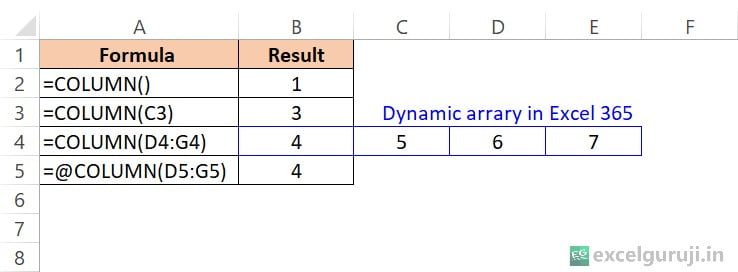Contents
Excel COLUMN Function

When to Use the Excel COLUMN Function in Excel
The COLUMN function in Excel is a valuable tool for retrieving the column number of a specific cell or reference. It is particularly useful when you need to perform calculations, data analysis, or cell referencing based on the column position.
What Excel COLUMN Function Returns
The Excel COLUMN function returns the column number of the specified cell or reference. This can be helpful in various scenarios, such as creating dynamic formulas that adapt to changes in column positions or when you need to identify the exact column where your data is located.
Syntax of Excel COLUMN Function
The syntax of the Excel COLUMN function is as follows:
=COLUMN([reference])
Input Arguments
Here is the input argument for the Excel COLUMN function:
● reference: This is an optional argument. If provided, it specifies the cell or reference for which you want to determine the column number. If omitted, it defaults to the cell in which the formula is entered.
Extra Notes
● The COLUMN function doesn’t require any specific format for the reference argument. It can be a cell reference, a range reference, or even a named range.
● If you reference multiple cells or a range, the function returns the column number of the leftmost cell in that range.
● A reference cannot point to multiple references or addresses.
Examples of the Excel COLUMN Function
Here are a few examples of using the COLUMN function in Excel:

Here is an explanation of the provided formulas and their results:
- =COLUMN(): This formula simply returns the column number of the cell where it is placed. In this case, it is placed in a cell without any arguments, so it returns 1, indicating it’s in the first column.
- =COLUMN(C3): This formula returns the column number of the cell reference provided as an argument, which is cell C3. As a result, it returns 3 because cell C3 is in the third column.
- =COLUMN(D4:G4): When you use the COLUMN function on a range like D4:G4, Excel 365 recognizes it as a range and returns the column numbers for each cell in that range. This is why you see the dynamic array result: 4, 5, 6, 7. Each number corresponds to a column within the specified range.
- =@COLUMN(D5:G5): By adding the ‘@’ symbol before the COLUMN function, you are telling Excel to use the implicit intersection operator (@). It returns the column number of the first cell where the formula and the range intersect. In this case, it is D5, which is in the fourth column, so it returns 4. This is useful for getting a single value from a range when working with dynamic arrays in Excel 365.
Conclusion
In conclusion, the Excel COLUMN function is a versatile tool that helps you work more efficiently with your data. Whether you are performing calculations, data analysis, or creating dynamic formulas, knowing the column number of a cell or reference can greatly simplify your tasks.
Mastering Excel functions takes practice, so don’t hesitate to experiment and explore different applications of the COLUMN function in your own projects. Start using the COLUMN function today and enhance your Excel skills.
Frequently Asked Questions (FAQs)
Q1: Can the COLUMN function return the column letter instead of the number?
A1: The COLUMN function returns the column number by default. If you want to get the column letter, you can use a combination of functions like the CHAR function.
Q2: Can the COLUMN function be used with multiple cells or ranges?
A2: Yes, you can use the COLUMN function with multiple cells or ranges to get the column number of the leftmost cell in the specified range.
Q3: What happens if the reference argument is omitted in the COLUMN function?
A3: If the reference argument is omitted, the COLUMN function defaults to the cell in which the formula is entered.
Q4: Can the COLUMN function be used in conjunction with other Excel functions?
A4: Yes, the COLUMN function can be used in combination with other functions to create dynamic and versatile Excel formulas.
Q5: Is the COLUMN function case-sensitive?
A5: No, the COLUMN function is not case-sensitive. It operates the same way regardless of whether you use uppercase or lowercase letters in your references.
Other Related Excel Functions
Mastering Excel CHOOSECOLS Function: Custom Data Extraction and Analysis
Mastering Excel CHOOSEROWS Function: Select and Extract Rows Like a Pro
Join me on Instagram, YouTube and WhatApp Channel for your daily dose of valuable tips and tricks! Catch insightful videos that will enhance your knowledge and skills. Don’t miss out – follow me now!